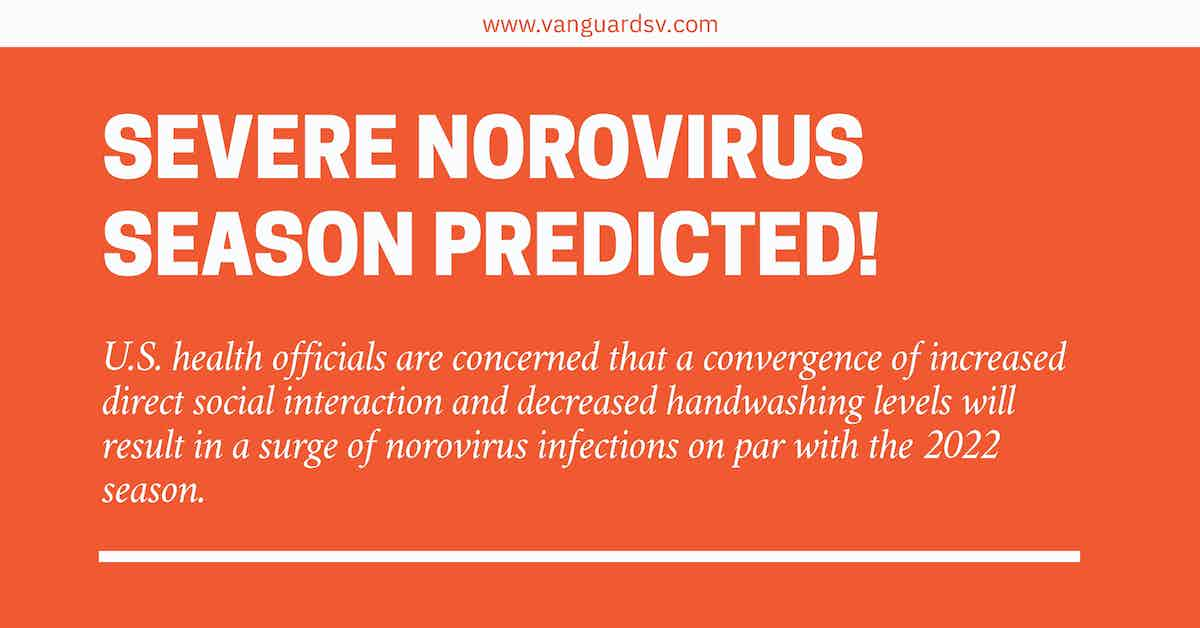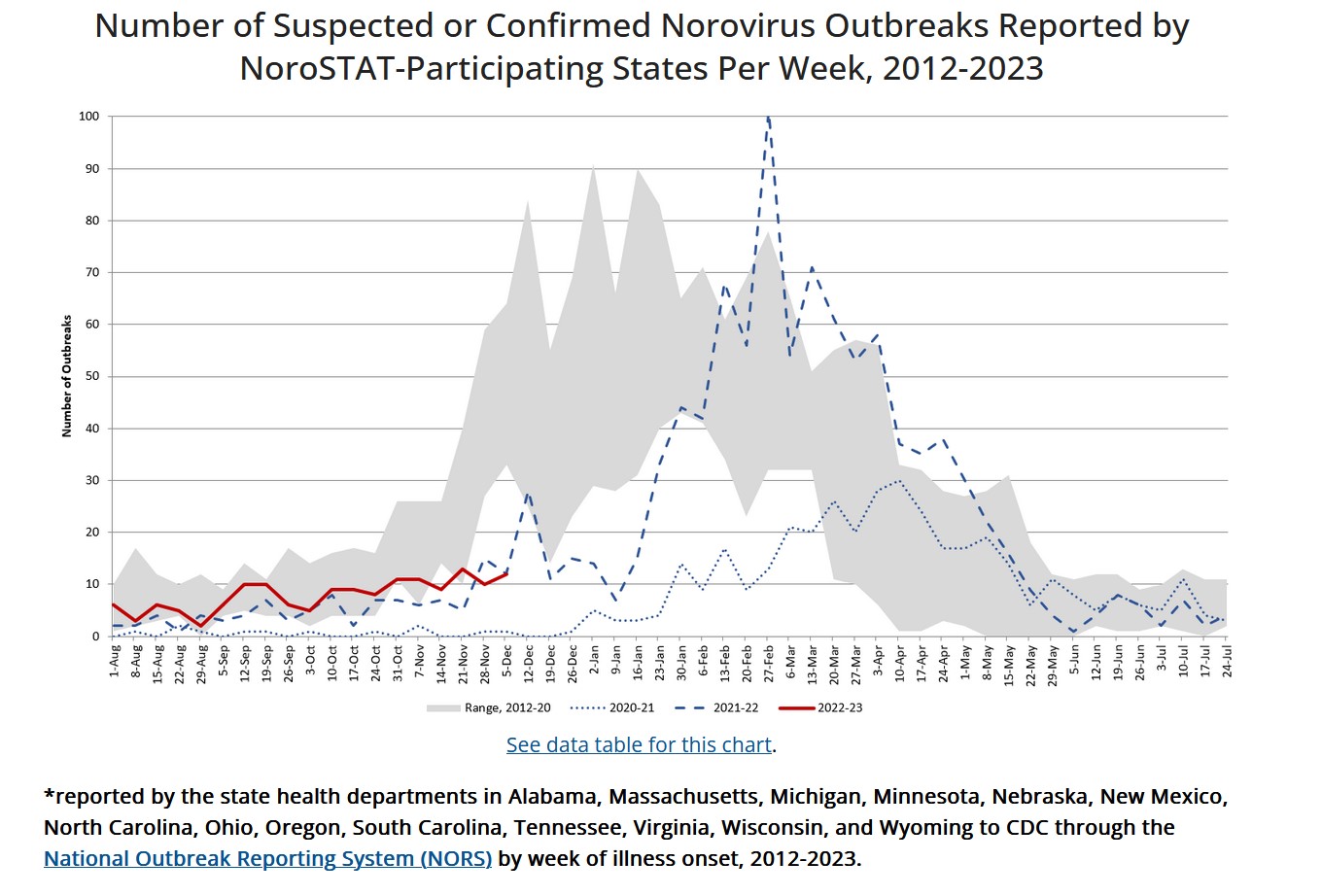U.S. health officials are concerned that a convergence of increased direct social interaction and decreased handwashing levels will result in a surge of norovirus infections on par with the 2022 season.

What COVID Did to Norovirus Infections
The U.S. public response to COVID significantly impacted norovirus transmission during the 2020-21 cold and flu season.
Reported infection rates during that period were far below the peak-season range of the previous eight years, followed by a record-setting spike in reported infections during the 2021-22 season.
Increased cleaning and disinfection frequencies, fantastical handwashing compliance, enforced social distancing, and widespread business closures contributed to the almost non-existent 2020-21 norovirus showing, just as the sudden reversal in those policies and behaviors, combined with lockdown fatigue, likely contributed to the dramatic increase in cases the following year.
Available data is only current to December 5, 2022--represented in the graph by the solid red line.
The line tracks several trends, and its trajectory could be interpreted in several ways.
However, several prominent health advisors have voiced concerns and are urging a return to many COVID-era conventions, including:
- Maintaining high levels of handwashing compliance.
- Screening employees, especially food service workers, for illness, particularly foodborne diseases, and;
- Increasing cleaning and disinfection rates and quality to maximize worker and customer safety.
According to Hal King, Ph.D., a Managing Partner of Active Food Safety and the Founder and CEO of Public Health Innovations;
In 2022, the U.S. saw the largest number of norovirus outbreaks in more than 10 years, even though the 2021-2022 norovirus season peaked late.
In 2023, we can expect even more norovirus infections will be circulating in our communities, and many of these infected persons will likely be workers and customers entering restaurants.
The best means to reduce the risk of transmission of norovirus in restaurants is to continue to screen employees for wellness (with a focus on all foodborne disease signs and symptoms), continue disinfection of high-touch surfaces in the restaurant (especially the restroom areas), and ensure proper hand hygiene and glove use before, during, and after food preparation.
Valid Hand Hygiene Concerns
Currently, several norovirus outbreak scenarios are possible, and nothing is for certain--but one thing that could contribute to a rise in norovirus cases is the sharp decline in reported hand hygiene since the start of the pandemic.
According to one recent study, handwashing compliance increased significantly during the first wave of the pandemic.
It returned to baseline, increasing twice more throughout the two-year period, though at a decreasing rate.
According to Infectious Disease Special Edition:
- Wave 1 (March 1 through June 30, 2020) - Hand hygiene compliance increased from a baseline of 43% adherence to a peak of 79%;
- Wave 2 (October 1, 2020, through February 28, 2021) - Compliance between pandemic waves decreased to baseline numbers and only increased to 53% during this period.; and
- Wave 3 (March 1 through May 31, 2021) - Compliance barely measured over baseline, at 52%.
Source:
Infection Prevention Strategies
Norovirus spreads through touch--contact with a contaminated person's hands or a contaminated surface, and then to the eyes, nose, or mouth.
Stopping the spread requires:
- Employing daily enhanced facility cleaning measures throughout all occupied areas of a building.
- Identifying and disinfecting high-touch surfaces two to three times daily.
- Using evidenced-based products that act quickly and are safe for food contact.
- Using disposable microfiber towels to clean food prep and dining surfaces.
- Cleaning and disinfecting high-risk restrooms, kitchens, and dining rooms daily.
- Stocking high-quality hand hygiene supplies and sanitary paper products.
- Establishing additional hand hygiene stations and primary entrances.
- Screening workers and customers for signs of illness and infection, and;
- Communicating all protocols, facility guidelines, and safety recommendations to all occupants.
Takeaway
Norovirus is deadly, highly contagious, and can survive for weeks on surfaces if left untreated.
Cleaning and hand hygiene intervention strategies are the only controllable methods for preventing another outbreak on par with the 2021-22 season.
According to Chip Manuel, Ph.D. and Food Safety Science Advisor at GOJO Industries;
Everyone needs to remember that norovirus is a highly contagious virus that spreads via person to person and by coming into contact with contaminated surfaces or food — it only takes a few virus particles to make someone sick, and a sick person sheds billions of particles of the virus in their vomit and feces.
Part of the reason why it's the #1 cause of foodborne illness in the U.S. is also that it can survive on surfaces for weeks.
So even if COVID-19 goes away tomorrow, surface and hand hygiene remain a critical piece to foodborne illness prevention, particularly norovirus — and particularly for foodservice establishments where one sick worker can spread norovirus throughout an establishment, including through the food they touch.
Unfortunately, handwashing compliance appears to be rapidly declining compared to the start of the COVID pandemic, leaving consistent and effective cleaning strategies as the only truly reliable method for ensuring occupant health and safety.
However, onboarding and managing the requisite labor and material resources necessary to ensure the highest standards of cleanliness are achieved and maintained may prove cost-prohibitive for many organizations.
Outsourcing is a proven method for onboarding highly in-demand cleaning and disinfection services and experience for a fraction of the price of maintaining a similar service in-house.
If you would like more information regarding the effectiveness of high-performance infection prevention and control measures, or if you would like to schedule a free, no-obligation on-site assessment of your facility's custodial needs, contact us today for a free quote!
In Bakersfield, CA, call (661) 437-3253
In Fresno, CA, call (559) 206-1059
In Valencia, CA, or Santa Clarita, CA, call (661) 437-3253
In Palmdale, CA, or Lancaster, CA, call (661) 371-4756



You must be logged in to post a comment.